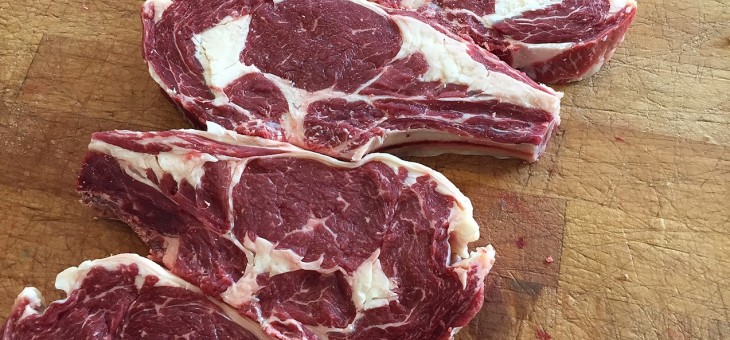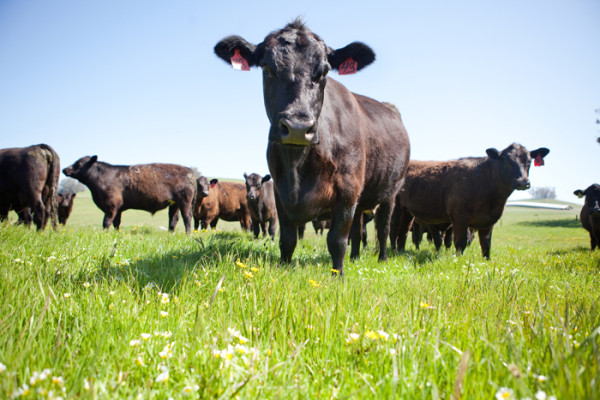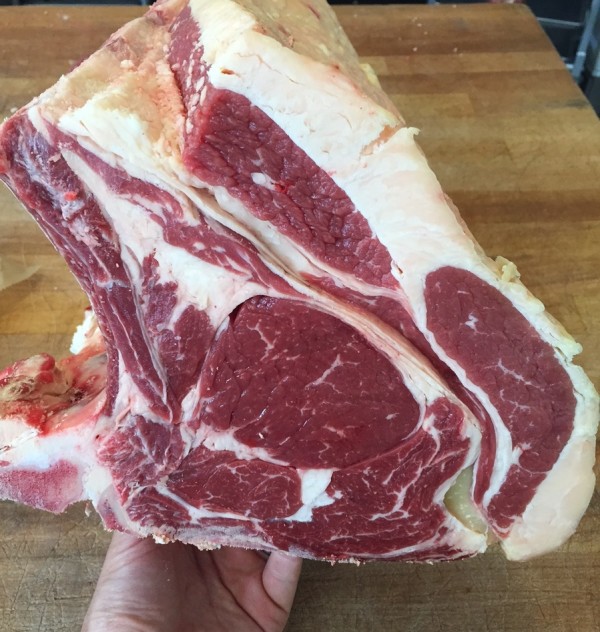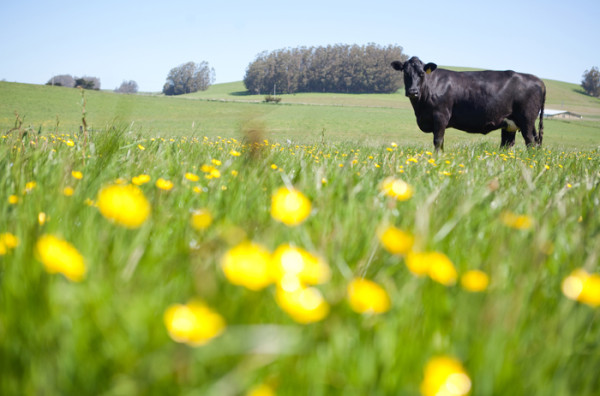
Summer is the season we obsess over heirloom tomatoes and colorful stone fruit at summer farmer’s markets. Here at The Local Butcher Shop, we’re also obsessing over the summer meat, specifically, grass-fed beef and lamb.
You might not think of meat having a season. After all, burgers never go off the menu, right? But considering the diets of the pastured animals we buy and how it changes from season to season, it begins to make sense.
Let’s take the grass-fed, grass finished beef from Stemple Creek Ranch that we sell in the shop. We talked with Loren Poncia, who owns and operates Stemple Creek with his wife Lisa, in Marin County.
“The secret to raising pastured beef is getting the cows fat on grass,” says Loren. In the late spring and summer, the grass is at its lushest and most nutritious in Northern California. The grass has gone to seed and is loaded with carbohydrates. Loren describes his summer pasture like a bovine buffet:
“The cows can eat whatever they want, but they pick what they need for their body. There are billions of microbes in a cow’s guts and they love the carbs. They tend to eat the really nutritious stuff first. If I were going to harvest an animal, and put beef away in the freezer, now would be the time,” says Loren.
This time of year, the pasture has the perfect amount of energy and provides the optimal growing condition for cows. The animals gain weight, develop cover and marbling, especially in the leaner cuts, which makes summer the season for steaks.
Its harder to have great beef in the winter time. During the (typically) wet winter months on the coast of Northern California, the ground is wet and there’s not as much sunshine. This stalls photosynthesis and the development of carbohydrates in the grasses. Instead, the grass is full of chlorophyl and water—it basically has the nutritional value of celery. So cows don’t fatten up much during the winter. This means there may be less intramuscular fat, less marbling and the meat is leaner. (Some cuts—like brisket, chuck, cross-rib—tend to be fatty all year and are great options for slow-cooked braises or roasts in the winter months.)
Farmers can supplement with dried grasses, hay or alfalfa, to help the animals maintain weight in the winter, but that can significantly increases a ranchers costs. Dry feed contains only 2 to 6% protein and carbohydrates, while lush spring and summer forage has up to 20%. That’s more energy to get the cows fat. Right now, a cow can put on three to four pounds a day! But maintaining a cow’s weight in the winter months can be a challenge for pastured beef operations.
Stemple Creek Ranch is able to provide The Local Butcher Shop with a year-round supply of beautiful beef by managing which cows graze in specific pastures. By rotating the herds through 100 different pastures, Loren is able to keep his cows on green grass constantly and still give the land ample time to rest and rejuvenate in between. That alone takes planning, but there’s also the variable of seasonal rainfall to consider. Loren is usually thinking four to six months ahead about where his herds will graze. During this drought, he’s looking up to 12 months out.
“Right now I’m thinking about when the first rain is going to fall. I’ve got a plan if rain comes by December 1st and another if it’s not here until February.” Stemple Creek has already cut back its herd and increased stocking density to gives the land more rest so green grass still grows during the drought. “It’s a continual dance with Mother Nature, and we’d rather have too much grass than too many cattle.”
I asked Loren if commodity beef operations have the same seasonal challenges.
“With feedlot beef the cow’s diet is controlled. You’re not relying on grass, sun and photosynthesis. No matter what the season, grain-fed animals get rapid weight gain, totally controlled,” says Loren. “Pastured beef is more expensive because it takes longer to raise a cow to market weight and the risks are greater.”
You can find Stemple Creek beef in retail butcher shops like ours and in some of the best Bay Area restaurants. You can also buy quarter, halves and whole animals direct from the ranch. Stemple Creek is hosting a few upcoming events, so you can visit the farm and meet the Poncia family.





Well done Kathryn! I love this family, and their delicious grass fed meats are what we choose for our table. Their ranch is a model of excellence others should take note of.
This is a good thing, let’s know the important sources of beef and thank you for sharing. Your ranch must be very beautiful, too.
Great post informing people about grass feeding and how it interacts with a cow’s body. Its great for people to know where their meat is coming from and how it is raised. Thanks so much for sharing!
Thank you for sharing this! It’s great for people to learn where they are getting their beef and the work that goes into making this beef as quality as possible for the consumer.